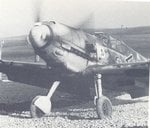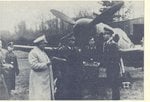Airframes
Benevolens Magister
Following on from the great pic posted by Grau Geist in the "Is modelling educational" thread, here's a little more info on some of the Messerschmitt 109's flown by Adolf Galland. It is by no means a comprehensive review of his aircraft, and I have refrained from posting all of the images I have found in books to date. If anyone else has more info, I, and I'm sure others, would love to see it.
As you will know, Adolf Galland started in WW2 as a Staffelkapitan with 4/LG2, flying Henschel HS 123 ground-attack biplanes. By April 1940, he'd moved to JG27 as Geschwader Adjutant, and then, on 6 June he was appointed as Gruppenkommandeur of III/JG26. At this time, his aircraft was a Me109E, with the blue 65 extending up the sides of the fuselage, which bore the 9 Staffel 'Hollenhund' badge. The Werke Nr. is not known.
By the time of the Battle of Britain, Galland was using another 'E', which was camouflaged in an unusual grey 75 mottle on ALL uppersurfaces, with blue 65 sides, and a black green 70 spinner. The fin and rudder was blue 65, with the grey mottle on the top half, the rudder bearing his victory bars in black, which, by mid-August, totalled 22.
By late August, Galland succeeded Handrick as Geschwader Kommodore, when he then flew a new aircraft, Werke Nr. 5819 for the remainder of the Battle of Britain, and up to April, 1941.
This aircraft was repainted more than once, and the shape and size of the Kommodore Winkel also changed. At one time, it was updated and re-engined, presumably with a DB601N, as the fuel triangle was changed to a 'C3' type, which is visible in the pic posted by Grau Geist. Photos 1 and 2 below show this aircraft, and it would appear that No 2 was taken around September, when the aircraft shows the '87' fuel triangle. Photo 2 also shows the capped spinner, painted, like the rest of the spinner, in white. Other shots of this aircraft show the uncapped spinner, and it is believed that this cap was eventually painted red. The spinner back-plate was black-green 70 in both cases. Werke Nr.5819 at one time displayed a yellow 04 top half to its rudder and, by late September 1940, it carried 40 victory bars. When the aircraft was later re-painted, with the well-known Mickey Mouse emblem being masked during the process, and the Schlageter badge appearing with slight differences, it is presumed that the area bearing the victory bars was also masked, as this then appeared as a blue 65 'patch', within the yellow 04 area, and by December 5, this 'patch' displayed 57 victory bars.
Apart from the changes to the colour scheme, Werke Nr.5819 also had some of Galland's personal modifications, including his famous cigar lighter in the cockpit (!) and the tele-sight through the un-armoured windshield, the latter clearly visible in photo No1. The canopy armour plate also lacked the curved head protection piece. This aircraft was eventually transferred to Egr.Gr.26, where it is thought that it bore a yellow '16' on the rear fuselage, as per the old 'Matchbox' 1/32nd scale kit. It also displayed the double-chevron Winkel of the Gruppenkommandeur, and a somewhat unusual splinter pattern on the upper wings, which did not appear to follow the 'standard' pattern. It also retained Galland's 'score board', this time in a different style on an all yellow rudder, and the tail-wheel aperture was faired over with sheet metal, a common field modification. (This was done during Galland's 'ownership')
After a rest period and refitting, JG26, with the exception of 7 Staffel under the command of Joachim Muncheberg in Gela, Sicily, moved to Guipavas, Brittany, and it was here that Galland started to use the Me109F-0, with the tele-sight fitted. This 109 was finished in 74, 75 over 76, with yellow 04 cowling and spinner, and, it is believed that the rudder was also yellow, with 58 victory bars.
When the unit moved back to the Pas De Calais area in the summer of 1941, with HQ at Audembert, Galland, from June until December, when he was appointed Inspecktor der Jagdflieger, flew two modified Me109 F's, one of which was believed to be Weke Nr. 5750, referred to as a Me109F6/U, and had a MG/FF cannon mounted in each wing, the modification being carried out at unit level. This was no mean achievement, as the weight of the weapons and ammunition, plus the stresses on the relatively lighter wing, must have been tremendous. The second machine, Werke Nr. unknown, was designated as a Me109F-2/U. This did not have the wing cannon, but the 7.92mm MG17's were replaced by two 13mm MG's, the breeches/receivers of which were accommodated by large blister fairings, which appeared 'smoother' and lower than those that eventually appeared on later 'G' models.
Both of these aircraft wore similar colour schemes of 74, 75 on upper surfaces, with 02 fuselage sides and a mottle of 74/75, and Weissblau 76 undersides. The spinners were black, whilst rudders were yellow 04, with the 'Oak Leaves' emblem, and 25 victory bars. The Winkel etc were in black and white, and the famous Mickey Mouse emblem was displayed beneath the cockpit sill. Photo 3, although poor quality, shows Werke Nr.5750, the 109F6/U, and the starboard wing cannon is just discernible.
If I am able in the not too distant future, I will produce and post some colour profiles to accompany this short article.
I trust that it has been interesting and useful and, if anyone can add any further info, I would be grateful.
Terry.
As you will know, Adolf Galland started in WW2 as a Staffelkapitan with 4/LG2, flying Henschel HS 123 ground-attack biplanes. By April 1940, he'd moved to JG27 as Geschwader Adjutant, and then, on 6 June he was appointed as Gruppenkommandeur of III/JG26. At this time, his aircraft was a Me109E, with the blue 65 extending up the sides of the fuselage, which bore the 9 Staffel 'Hollenhund' badge. The Werke Nr. is not known.
By the time of the Battle of Britain, Galland was using another 'E', which was camouflaged in an unusual grey 75 mottle on ALL uppersurfaces, with blue 65 sides, and a black green 70 spinner. The fin and rudder was blue 65, with the grey mottle on the top half, the rudder bearing his victory bars in black, which, by mid-August, totalled 22.
By late August, Galland succeeded Handrick as Geschwader Kommodore, when he then flew a new aircraft, Werke Nr. 5819 for the remainder of the Battle of Britain, and up to April, 1941.
This aircraft was repainted more than once, and the shape and size of the Kommodore Winkel also changed. At one time, it was updated and re-engined, presumably with a DB601N, as the fuel triangle was changed to a 'C3' type, which is visible in the pic posted by Grau Geist. Photos 1 and 2 below show this aircraft, and it would appear that No 2 was taken around September, when the aircraft shows the '87' fuel triangle. Photo 2 also shows the capped spinner, painted, like the rest of the spinner, in white. Other shots of this aircraft show the uncapped spinner, and it is believed that this cap was eventually painted red. The spinner back-plate was black-green 70 in both cases. Werke Nr.5819 at one time displayed a yellow 04 top half to its rudder and, by late September 1940, it carried 40 victory bars. When the aircraft was later re-painted, with the well-known Mickey Mouse emblem being masked during the process, and the Schlageter badge appearing with slight differences, it is presumed that the area bearing the victory bars was also masked, as this then appeared as a blue 65 'patch', within the yellow 04 area, and by December 5, this 'patch' displayed 57 victory bars.
Apart from the changes to the colour scheme, Werke Nr.5819 also had some of Galland's personal modifications, including his famous cigar lighter in the cockpit (!) and the tele-sight through the un-armoured windshield, the latter clearly visible in photo No1. The canopy armour plate also lacked the curved head protection piece. This aircraft was eventually transferred to Egr.Gr.26, where it is thought that it bore a yellow '16' on the rear fuselage, as per the old 'Matchbox' 1/32nd scale kit. It also displayed the double-chevron Winkel of the Gruppenkommandeur, and a somewhat unusual splinter pattern on the upper wings, which did not appear to follow the 'standard' pattern. It also retained Galland's 'score board', this time in a different style on an all yellow rudder, and the tail-wheel aperture was faired over with sheet metal, a common field modification. (This was done during Galland's 'ownership')
After a rest period and refitting, JG26, with the exception of 7 Staffel under the command of Joachim Muncheberg in Gela, Sicily, moved to Guipavas, Brittany, and it was here that Galland started to use the Me109F-0, with the tele-sight fitted. This 109 was finished in 74, 75 over 76, with yellow 04 cowling and spinner, and, it is believed that the rudder was also yellow, with 58 victory bars.
When the unit moved back to the Pas De Calais area in the summer of 1941, with HQ at Audembert, Galland, from June until December, when he was appointed Inspecktor der Jagdflieger, flew two modified Me109 F's, one of which was believed to be Weke Nr. 5750, referred to as a Me109F6/U, and had a MG/FF cannon mounted in each wing, the modification being carried out at unit level. This was no mean achievement, as the weight of the weapons and ammunition, plus the stresses on the relatively lighter wing, must have been tremendous. The second machine, Werke Nr. unknown, was designated as a Me109F-2/U. This did not have the wing cannon, but the 7.92mm MG17's were replaced by two 13mm MG's, the breeches/receivers of which were accommodated by large blister fairings, which appeared 'smoother' and lower than those that eventually appeared on later 'G' models.
Both of these aircraft wore similar colour schemes of 74, 75 on upper surfaces, with 02 fuselage sides and a mottle of 74/75, and Weissblau 76 undersides. The spinners were black, whilst rudders were yellow 04, with the 'Oak Leaves' emblem, and 25 victory bars. The Winkel etc were in black and white, and the famous Mickey Mouse emblem was displayed beneath the cockpit sill. Photo 3, although poor quality, shows Werke Nr.5750, the 109F6/U, and the starboard wing cannon is just discernible.
If I am able in the not too distant future, I will produce and post some colour profiles to accompany this short article.
I trust that it has been interesting and useful and, if anyone can add any further info, I would be grateful.
Terry.



